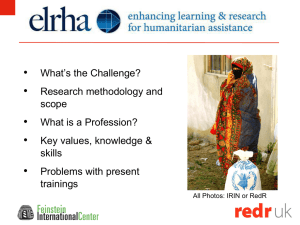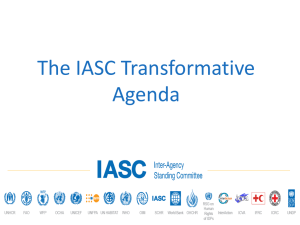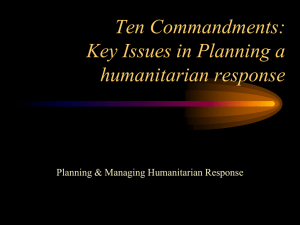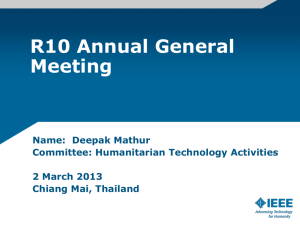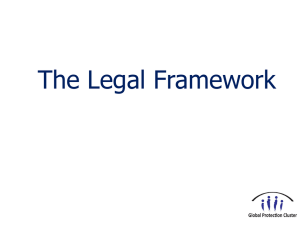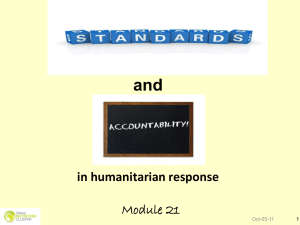Key Stakeholders In Humanitarian Assistance
advertisement
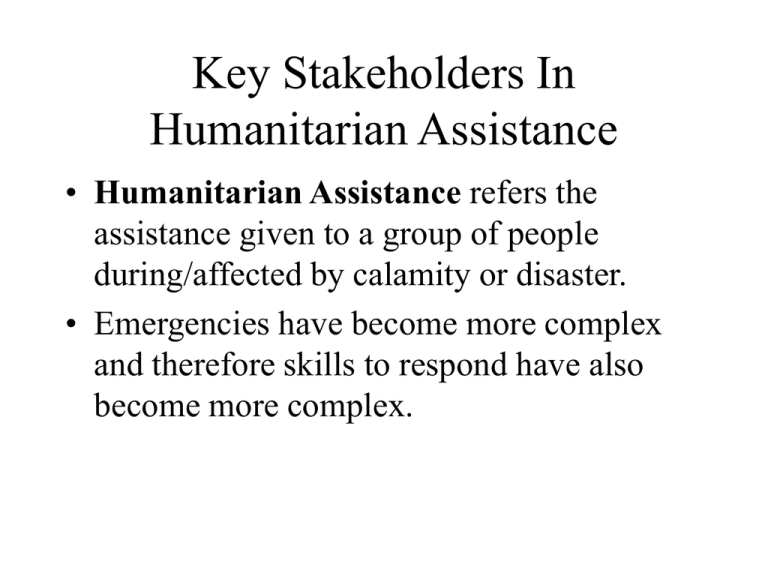
Key Stakeholders In Humanitarian Assistance • Humanitarian Assistance refers the assistance given to a group of people during/affected by calamity or disaster. • Emergencies have become more complex and therefore skills to respond have also become more complex. Key Stakeholders cont.. • • • • • • • Major Humanitarian agencies: ICRC IFRC MSF Oxfam Save the Children Tearfund and many others in recent years Key Stakeholders cont.. • Responsibilities of Humanitarian Agencies is to provide: • Shelter • Food • Water • Health services • Psychological/emotional needs Key Stakeholders cont.. • The Humanitarian Charter governs the Roles and responsibilities of Humanitarian Assistance. The Charter is based on the principles and provisions. • The Humanitarian Charter governs the Roles and responsibilities of Humanitarian Assistance. Key Stakeholders cont.. • The Charter is based on the principles and provisions of: • The International Humanitarian Law • Refugee Law • The code of conduct for the ICRC and the Red Crescent Movement and the NGOs in Disaster Relief Key Stakeholders cont.. • The Charter describes the core principles that govern humanitarian action and asserts the right to populations to protection and assistance. • It defines the legal responsibilities of states and parties to guarantee the right to assistance and protection • When states are unable to respond, they are obliged to allow interventions of humanitarian organizations. Key Stakeholders cont.. • Minimum Standards (SPHERE PROJECT) • Provide guidelines on how to respond to the needs of the affected in order to achieve impact. • Limitations of the Humanitarian Charter and Minimum Standards: • Political and security factors outside the control of the humanitarian agencies Key Stakeholders cont.. • The extent to which the agencies have access to the affected population • The availability of sufficient financial, human and material resources is essential • The cooperation of the authorities in charge, and whether they can operate in conditions of reasonable security. • The Charter is a set of general principles and do not attempt to deal with the whole spectrum humanitarian concerns. Principles of the humanitarian Charter 1. The right of life with dignity reflected in: • The right to an adequate standard of living • Freedom from cruel, inhuman or degrading treatment or punishment • Not with holding or frustrating the provision of life-saving assistance Principles of the humanitarian Charter 2. Non-combatants are entitled to immunity from attack. 3. The principle of re-foulement. No refugee shall be sent back to a country which is or his life or freedom would be threatened ROLES AND RESPONSIBILITIES Those affected are entitled to protection and assistance Recognition and support the protection and assistance mandates of the ICRC and UNHCR under the control of the human agencies. The SPHERE Project • The minimum standards are based on agencies experiences of providing humanitarian assistance • The achievement of the standards depends on a large range of factors, many which may be outside the control of the agencies. The Sphere Project • Started in 1997, born out of the of the inconsistencies in disaster response and lack of accountability • Developed by the Steering Committee for Human Response and InterAction. Red Crescent Networks represent many hundreds of agencies committed to improving in quality and accountability of disaster response. • SPHERE minimum standards have been universally tested in various set ups. The Sphere Project cont.. • Sphere is a consolidation of standards to enable the agencies undertake their work in a more professional, responsible and and accountable manner • Based on the Humanitarian Charter • It covers: _ water supply and sanitation, - nutrition – Food Aid, shelter and site planning – Health services The Sphere Project cont.. • The project is: 1. A Process: It gives guidelines on how to implement assistance. It gives the minimum levels to be attained in each area of assistance The key indicators that show that standards have been attained. 2. Handbook: it provides guidance notes to include practical guidance 3. Commitment: Reflects a legal and moral commitment to adhere the standards Minimum Standards in Nutrition • • • • • • Initial Assessment of nutritional situation Response based on the causes of malnutrition Monitoring and Evaluation Community participation General nutritional support for the population Nutritional support to those suffering from malnutrition • Human resource capacity building and training • Competence of staff • Use of local capacity and skills


